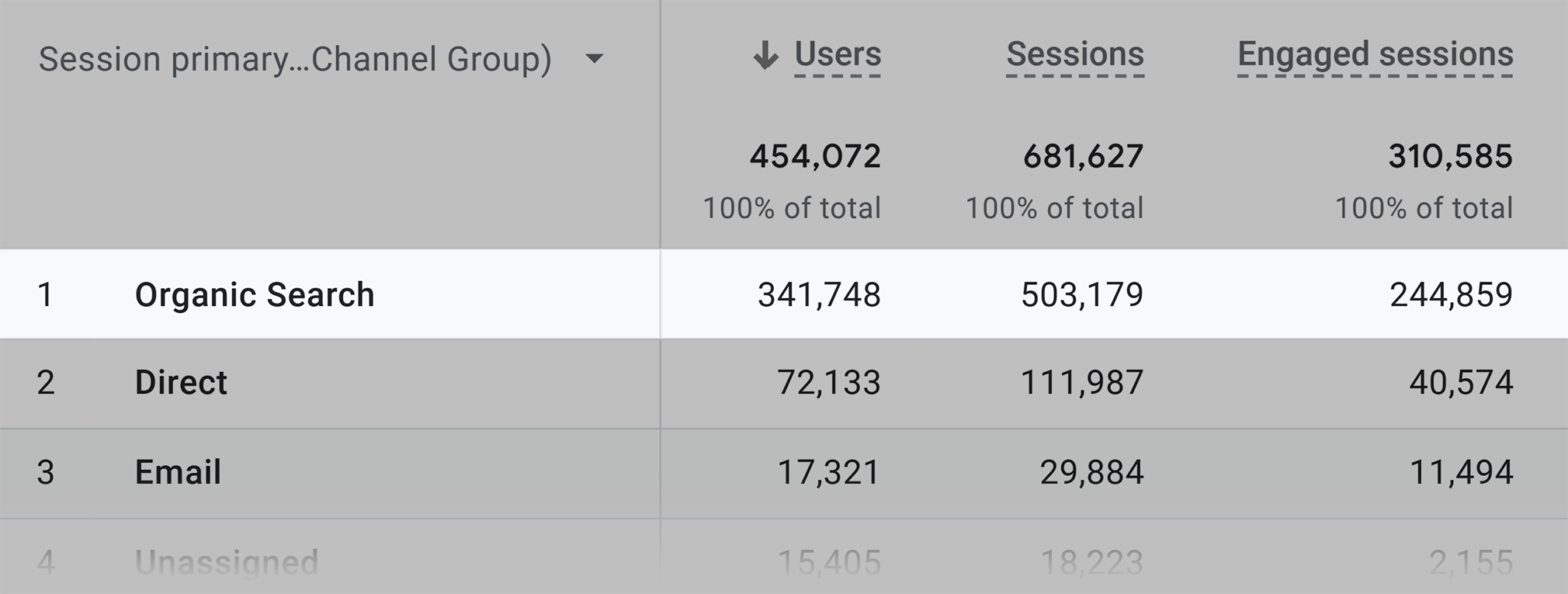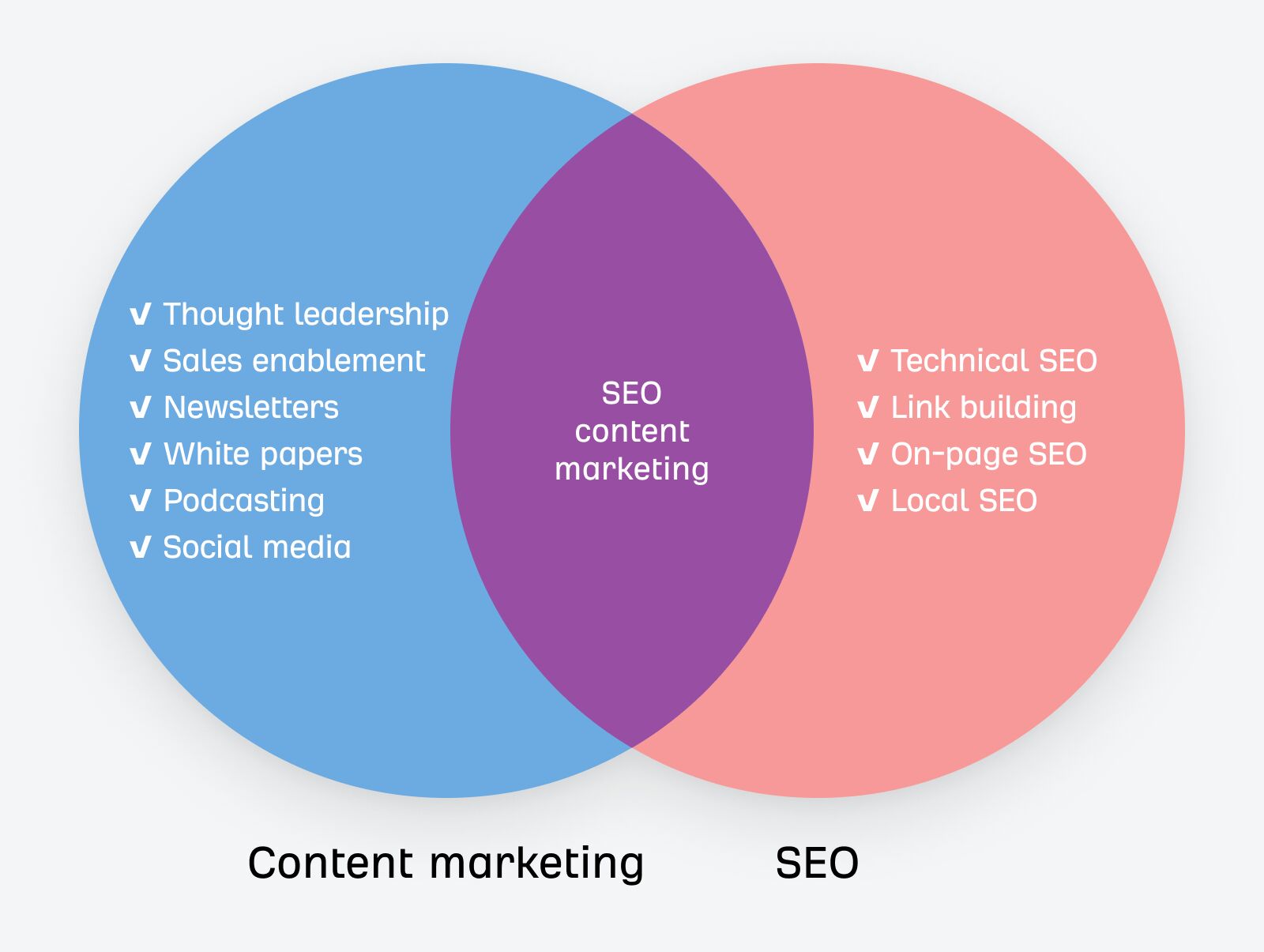In this guide, we’re diving into twelve content marketing tactics we’ve tested and continue to use with some decent results. We know they work, and we’re excited to show you the proof.
Generally speaking, low-competition keywords are search terms where you likely don’t need many backlinks to rank on the first page of Google (backlinks are one of the most important ranking factors).
By focusing on these less competitive terms, you can achieve higher search engine rankings faster and with less effort; and the higher the rankings, generally the more traffic lands on your site. This makes low-competition keywords a perfect SEO tactic for new sites and sites without a strong backlink profile.
To illustrate our results, here’s a heatmap showing the relationship between keyword difficulty and Google rankings for nearly 200 pages from our SEO glossary content project.
We were able to rank in the top ten with few links and a templated content approach. But that wasn’t enough for mid to high KD keywords; these would require more comprehensive content and additional backlinks.
How to get started
Use a tool like Ahrefs’ Keywords Explorer to quickly find keywords that need fewer backlinks to rank.
- Enter a seed keyword (or multiple seed keywords).
- Go to the Matching terms report.
- Use the KD (Keyword Difficulty) metric to show keywords with up to 20 KD. This will show you easy keywords based on the backlink profile.
- Pick a relevant keyword and open the SERP panel to see what kinds of pages rank. If you see popular brands dominating, those keywords may be hard to rank despite the low KD (here’s why). SERPs without brands like that should be easier to target.
- Repeat step #3 for every relevant keyword on the list.
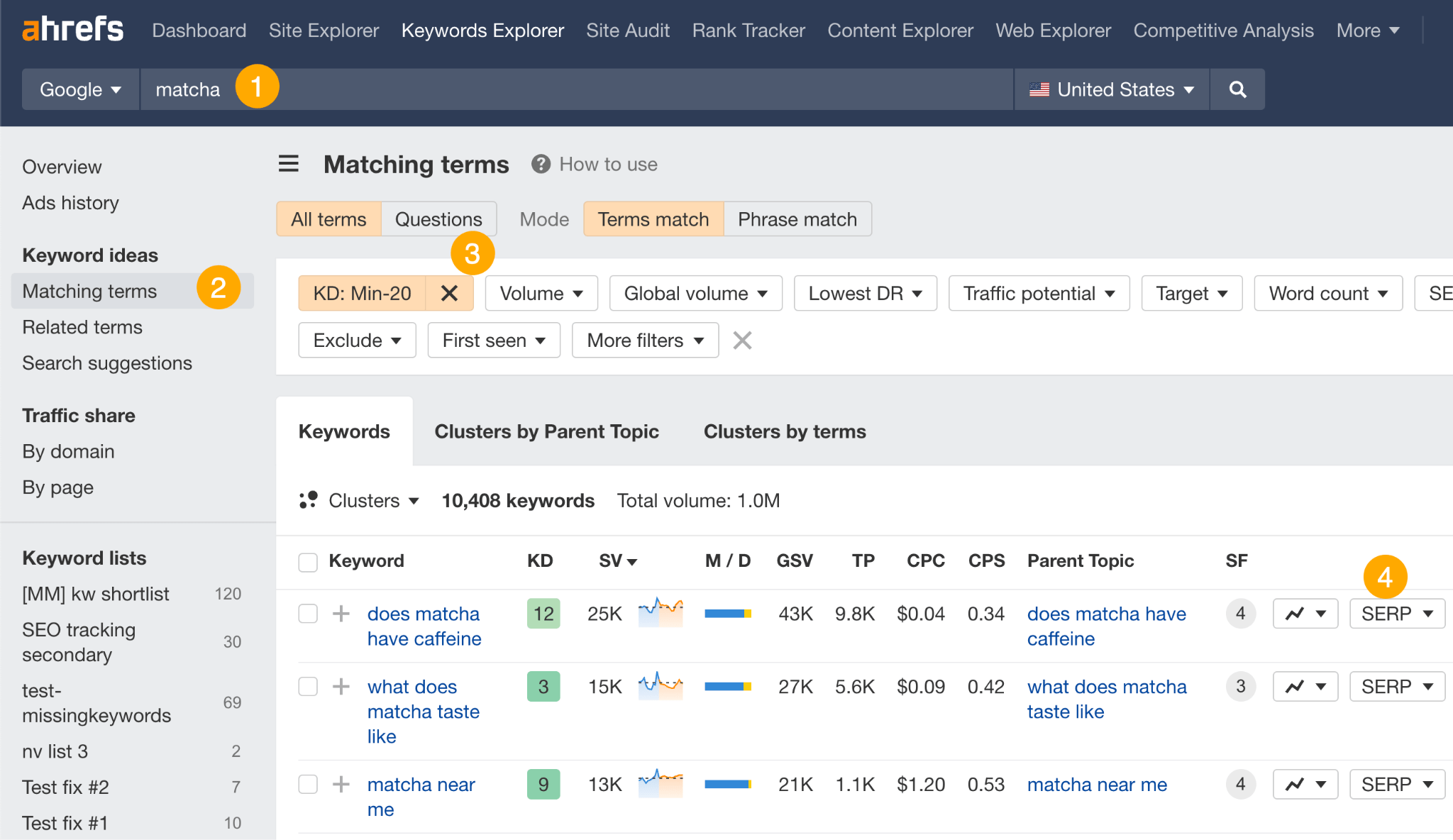
And here’s an example of a keyword with low KD and just a few strong sites (based on the Domain Rating metric).

Tip
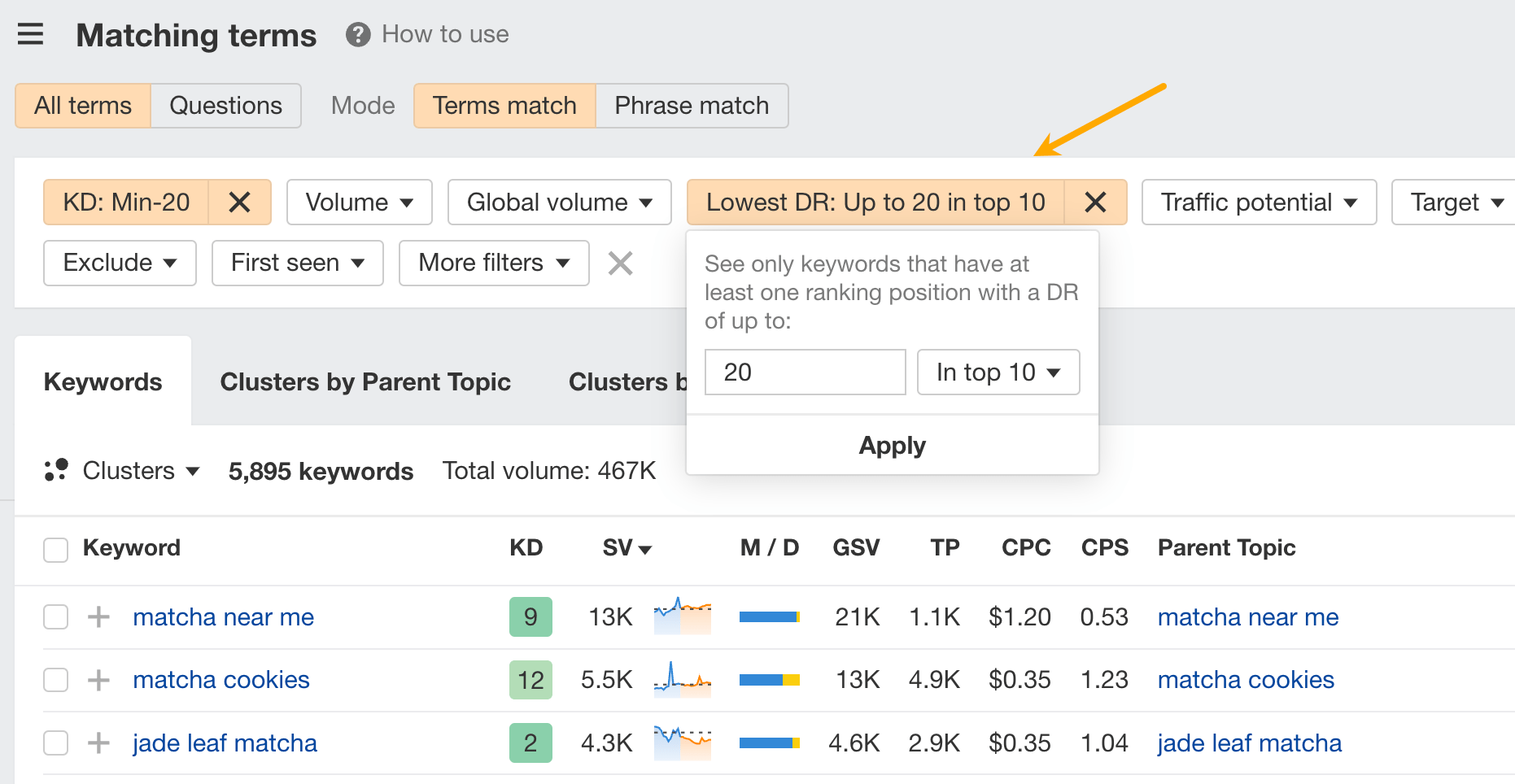
Building a network involves creating and nurturing relationships that can amplify your message and expand your reach. These connections can be made through social media, online communities, forums, meetups, and conferences.
When other people share and engage with your content, you’ve got a higher chance of cutting through the noise of today’s information-saturated world making your content noticed and valued.
Here’s a small sample. At Ahrefs, we often seek expert commentary to enhance our content. I reached out to Ashley Faus with one simple question about her article and she was kind enough to share my article with her audience of 13K people (I didn’t even ask for it).
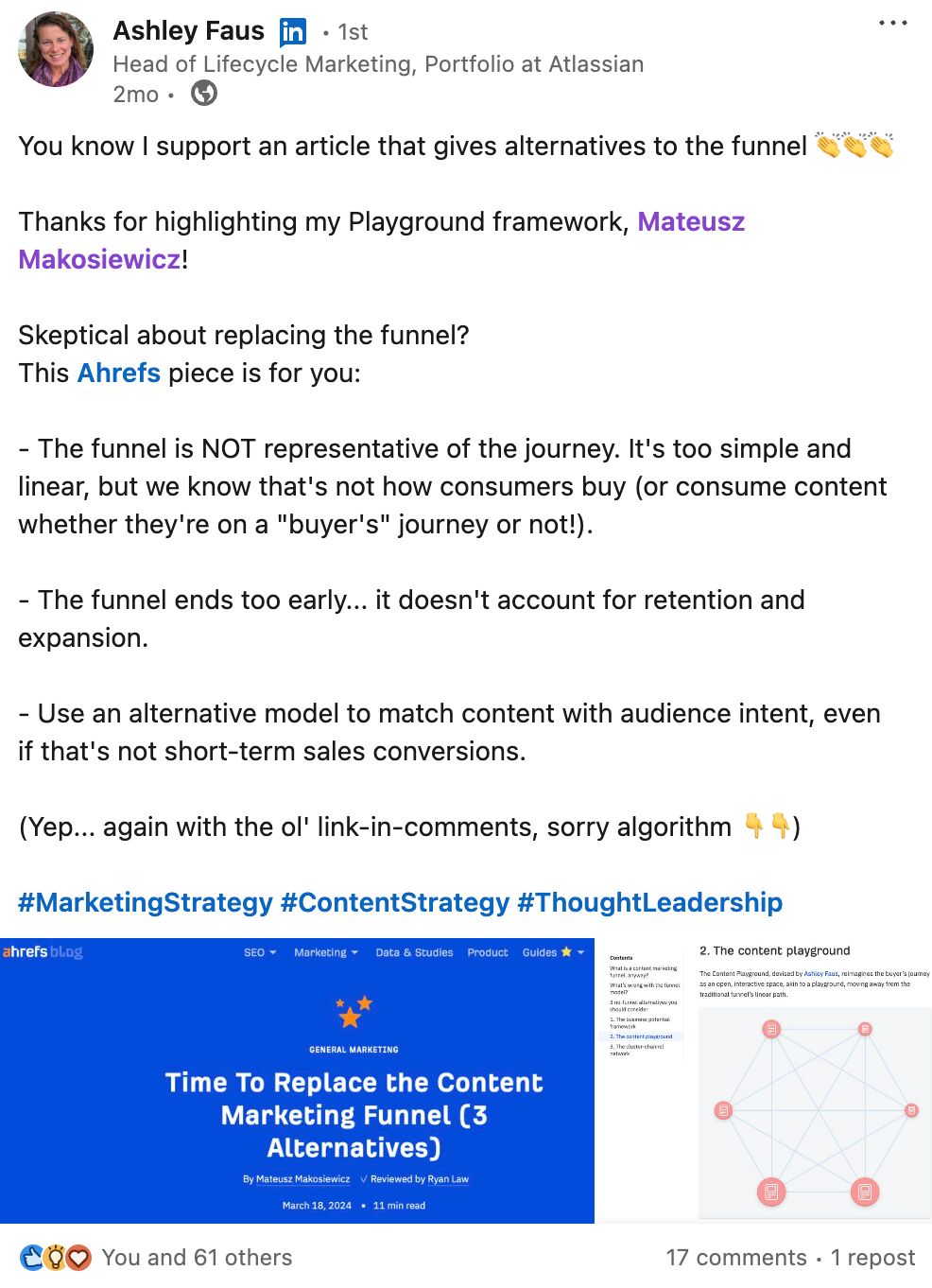
Not everyone will be as generous as Ashley, but you have to assume they will.
How to get started
There are two approaches to this: broad and targeted.
In the first one, you leverage things that typically engage people on social media and weave them into your content. Rand Fishkin, in his article on content amplification, calls these share-inducing emotions, for example:
- Novelty: An article about “A cat learned to use sign language” will attract more attention than “Cats can meow.”
- Belief reinforcement: A report linking organic food to better health will be shared by those who already support organic farming.
- Fear: A headline like “New disease spreading rapidly” will get more shares than “Health improvements in 2024.”
- Controversy: Debates over “Climate change policies” attract more engagement than consensus articles.
There’s also the targeted approach, and it’s a whole different beast — it needs customization, good research, and etiquette. You need to get that person’s attention with something they will likely care about (such as their work), but you can’t ask for anything in return.
And that is exactly what happened in the example I shared above. No strings attached, just a simple request from one professional to another.
Publishing original research is a proven method to boost your SEO through backlinks (links from other sites) and becoming a thought leader in your niche through references to your work.
When you create original studies, like data analyses, case studies, or industry surveys, other authors will often use them as sources, which means more backlinks for you. These backlinks increase your site’s website’s authority, which can help other important pages on your site rank better too.
For example, we did a study on why most web content doesn’t get organic traffic and got 6K backlinks from 2.9K different sites, and those numbers keep growing without us lifting a finger.
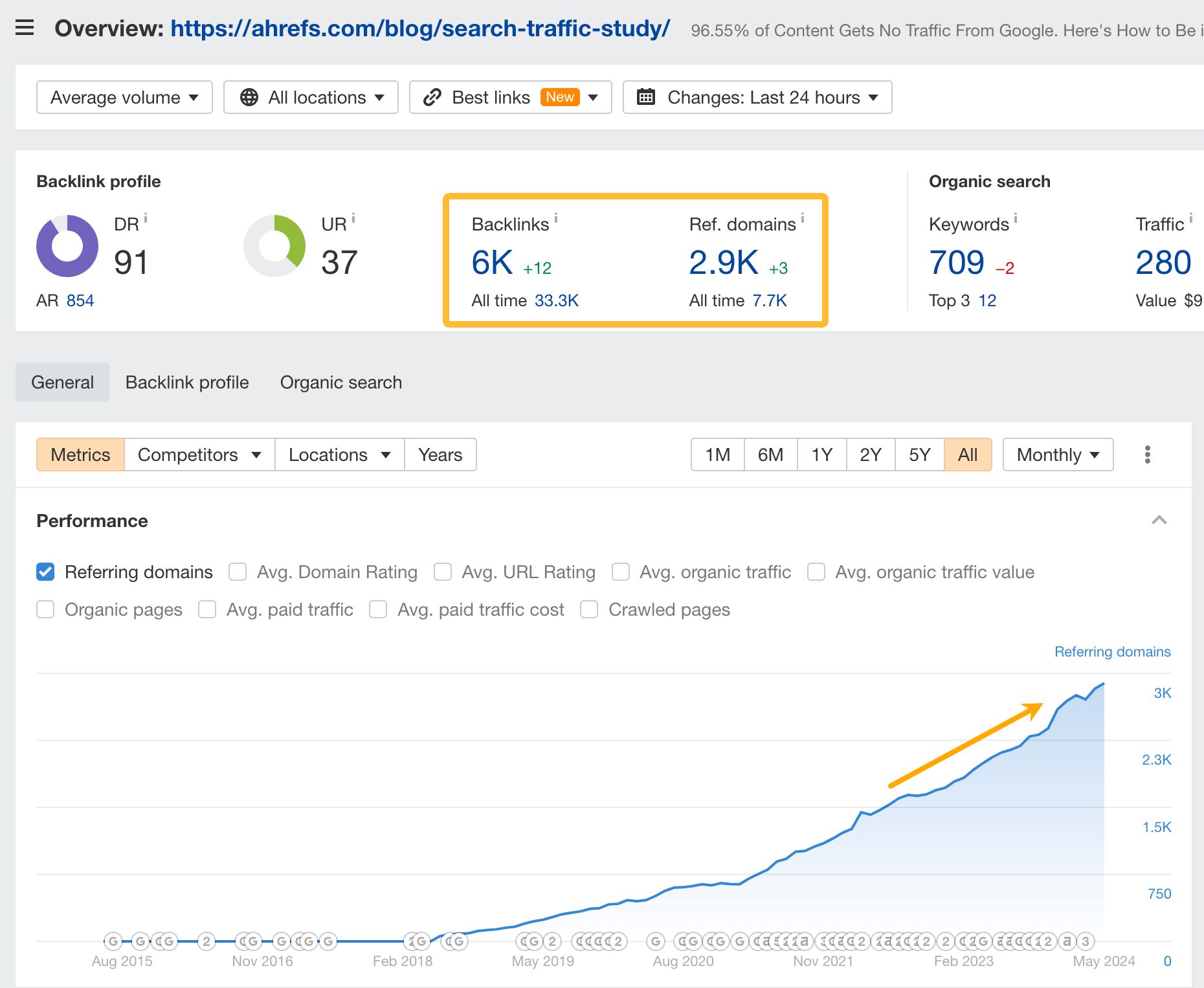
Besides improving your SEO, original research makes you a thought leader in your field. When other sites mention your research, it boosts your reputation, making you a trusted and respected brand.
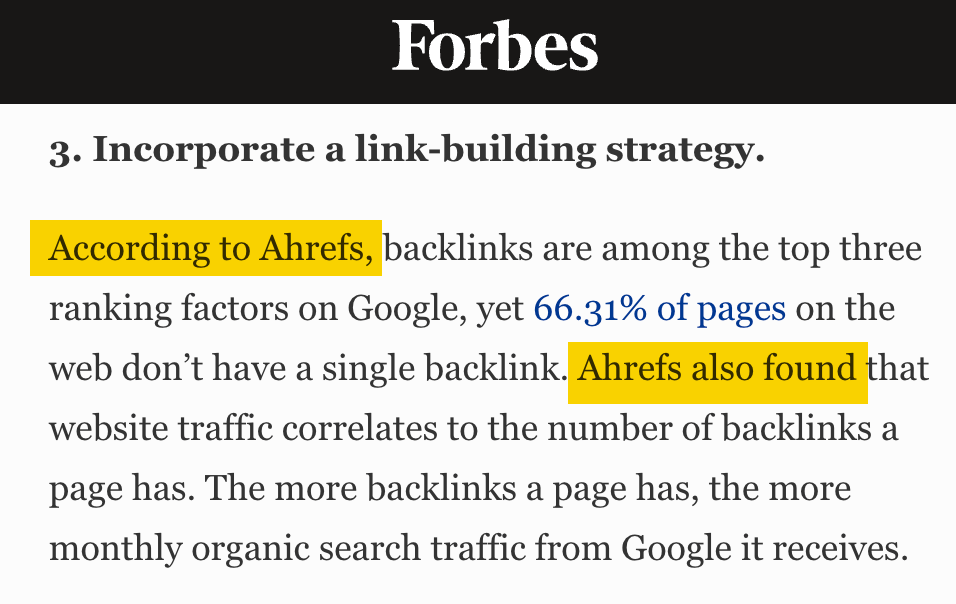
How to get started
Coming up with research ideas doesn’t have to be hard.
For example, to find relevant research about SEO, we use Ahrefs’ Content Explorer to look for content that has “study” in the title and at least 200 referring domains (to weed out some less popular ones).

Partnering with influencers involves paid collaboration with content creators who have a significant following (e.g., on social media or through an email list) in your target market.
Influencer partnerships are effective because they leverage the trust and loyalty that influencers have built with their audience. This authentic endorsement can introduce your brand to niche markets, sometimes more effectively than traditional advertising.
And last but not least, as a sponsor you get to feature your brand in some really unique, quality content.
We’ve been using this tactic on a constant basis for three years, now. Here are just a few examples of the amazing content from our partners.
The first is an hour-long workshop on competitive analysis for a content marketing and SEO community. This video promotes both free and our core toolset, generating 1.8k views.
And here’s a sponsored video by one of the top influencers in the SEO industry. This video promotes our free academy and our free SEO tool, generating 50k views.
And here’s a contextual ad on a channel with over 500K subscribers. This promotes our core toolset, generating 19K views.
As you can see, we’ve chosen to work with both small and big influencers, and what we promote depends on the audience and the topic. But in any case, it pays to have some kind of free offering to hook the viewers on the value you provide as a business with minimum friction.
How to get started
To find the right influencer, there are a few steps you need to take.
- Define your goals. Clearly outline what you aim to achieve with influencer marketing, such as increasing brand awareness, driving engagement, or boosting sign-ups.
- Figure out your budget. You can use average influencer earnings data like this one to estimate the budget.
- Identify potential influencers. Here are a few ideas:
- Start by considering your own employees and customers who might already be fans of your brand and have a following .
- Use social media platforms and specialized tools like Ahrefs’ Content Explorer, Sparktoro, Social Blade, and Followerwonk to find relevant influencers based on your niche and keywords.
- Seek recommendations from your audience.
- Evaluate influencers. Ensure that the influencers align with your brand values and have genuine engagement. Look beyond follower counts to assess their influence and audience interaction.
- Monitor and measure. Ask the creator to share reports with you (including content output and engagement metrics).
Find out more about finding influencers to partner with in our guide, Find Influencers: 6 Easy Steps to Choose the Right Ones.
Using content templates and programmatic SEO is about producing more content in less time, with the latter allowing you to actually automate content production.
With templates, you can set up a standard format and just fill in the details. It’s great for things like product pages, definition glossaries or local listings where you need similar content for many items.
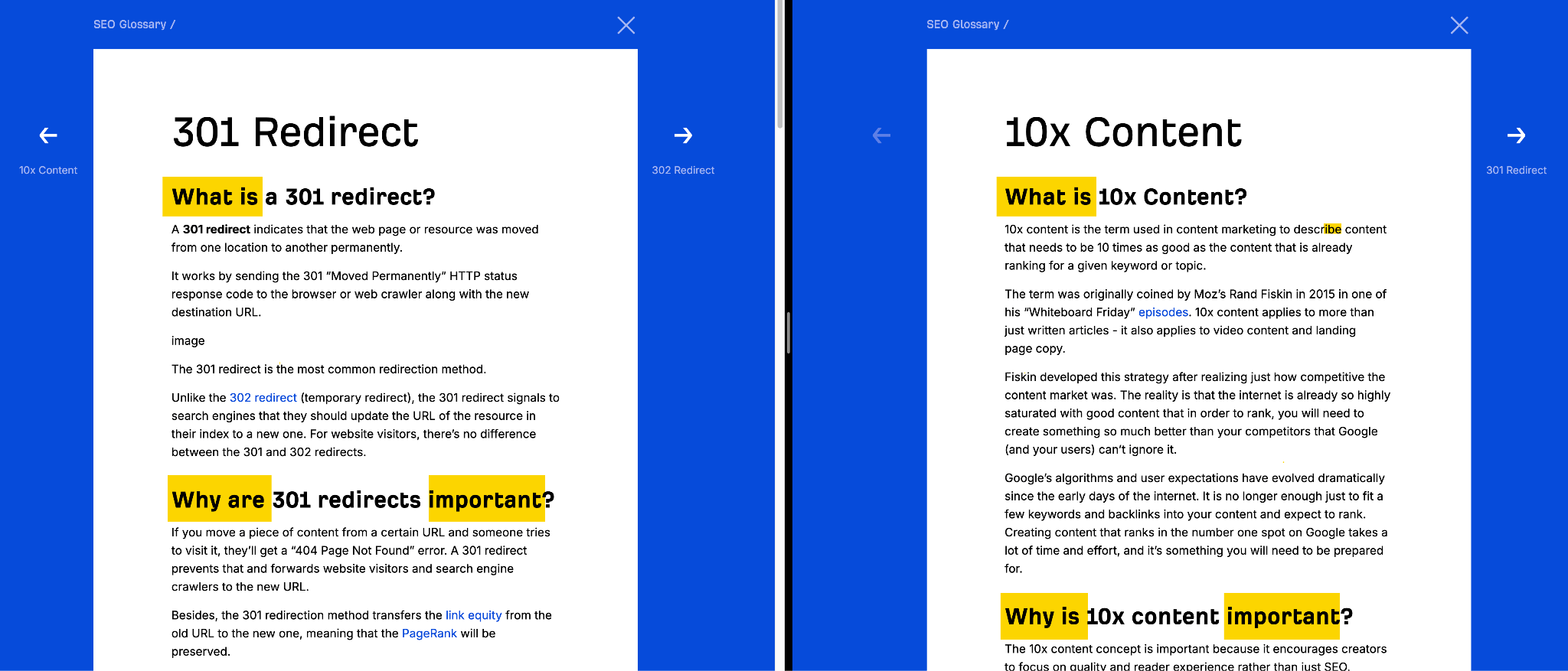
We used templates to create an SEO glossary and a directory of beginner-focused SEO guides for different professions. As of today, they’re bringing in a total of 67k visits each month.

Programmatic SEO is basically content templates on steroids. Programmatic pages are usually created automatically directly from data, like product prices, weather, or location information. This lets you cover many keywords and topics without writing everything by hand.
We used programmatic SEO to take advantage of huge search demand for free AI writing tools. We drive over 600K monthly search visits this way, and you can see on the graph below how this approach allowed us to publish dozens of pages in a day (sharp spikes on the yellow line).
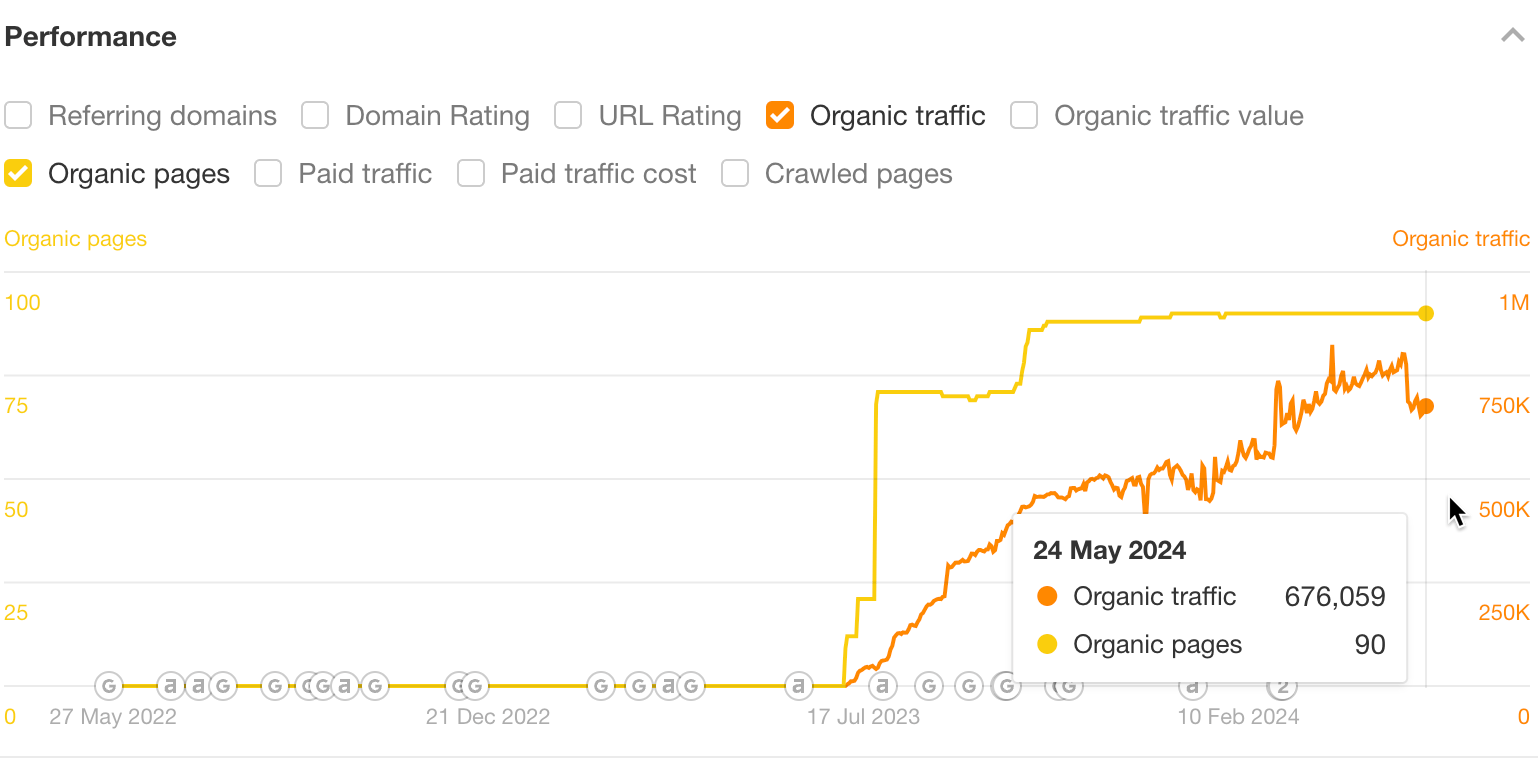
How to get started
First, you need a set of keywords that could be targeted with similar types of content. One of the best ways to do this is to use a keyword research tool to categorize your keywords by terms. Terms like “definition”, “what is”, or “cost of living” indicate that people want the same kind of content for different topics.
- Open Ahrefs’ Keywords Explorer and enter a broad seed keyword, for instance “marketing”.
- Go to the Matching terms report.
- Open the Terms tab and browse through keyword categories.

Here’s an example – over 4.6K search keywords requiring definitions which could be targeted with the same page template.

Further reading
Our old newsletter was basically a handful of links to our latest blog posts, but then we made some changes:
- We started sharing useful stuff from other brands and creators.
- We stopped sharing “every” blog post; only the ones with a true FOMO value.
- We group news by topic and write a quick blurb for each to save people time.
- We made it fun. Every Ahrefs’ Digest kicks off with a meme:
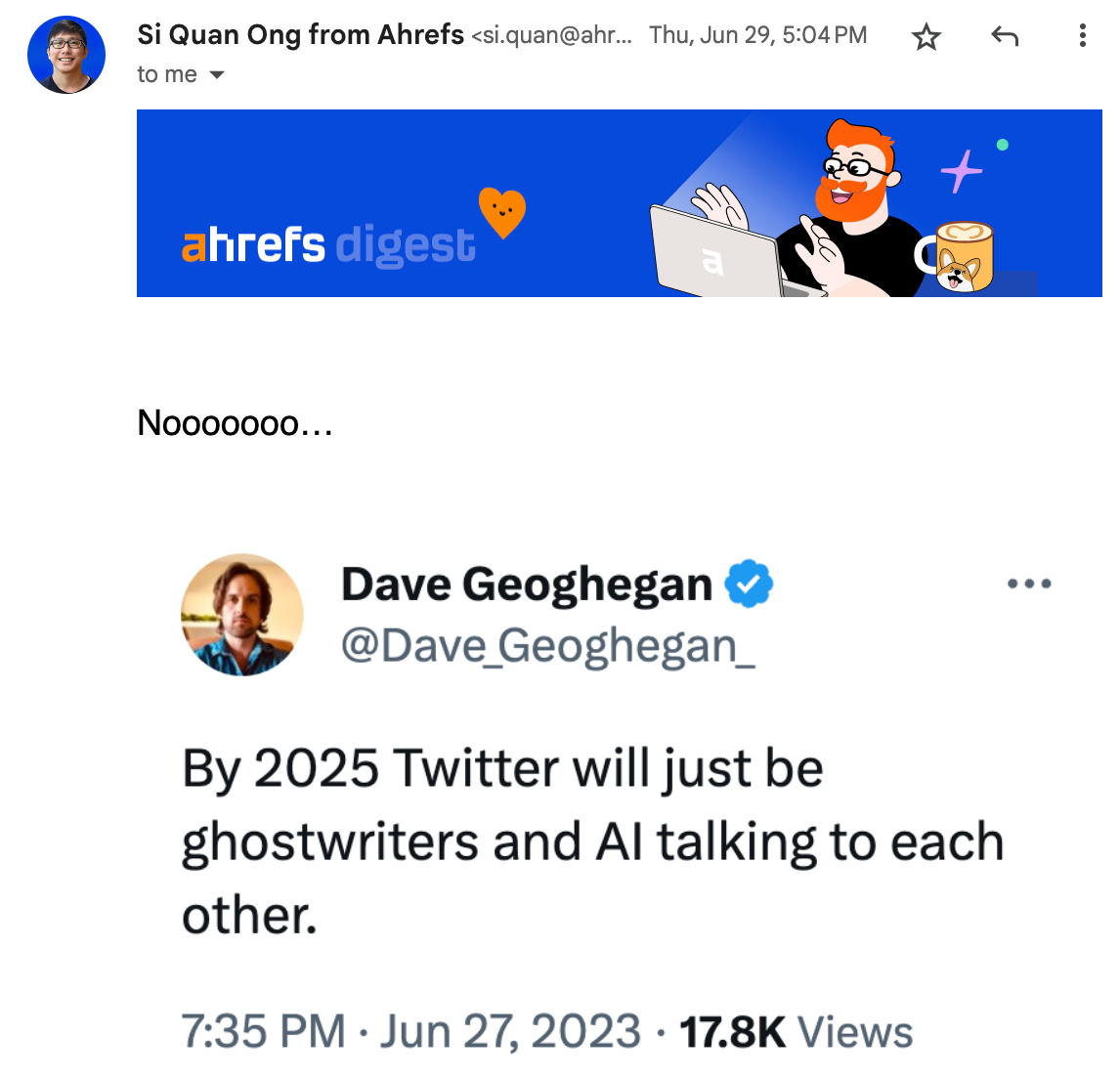
And it worked. People really seemed to appreciate the changes:
I appreciate the TLDR respect that @ahrefs puts into their newsletter. Less is more!
— Adam J. Humphreys (@Making8) June 6, 2022
Some people will never bother to read a newsletter. But there are people who turn to newsletters because they save them time searching for valuable information — that’s where you come in.
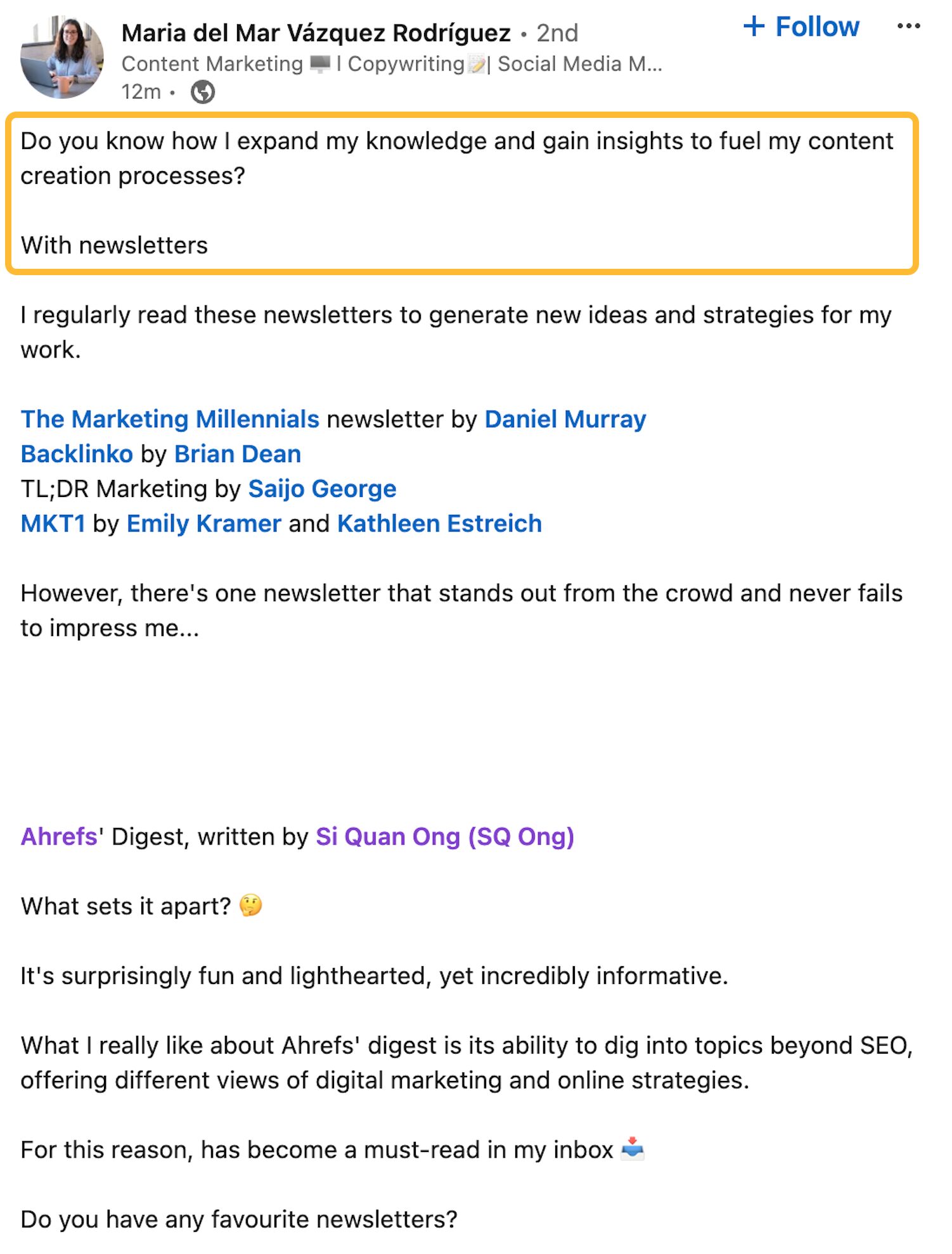
How to get started
Technically, starting a newsletter is straightforward — sign up for a tool like Mailchimp and get all the tools you need to start collecting emails and sending newsletters.
But what matters the most and is not that easy when you’re starting out is the content and consistency. Here are some key factors to consider:
- Provide valuable, relevant, and unique content that addresses your audience’s needs and interests. It doesn’t have to be 100% your original content. Curating all the stuff that gets published online every week is a value on its own. If you’re not sure where to start with this, simply make this newsletter something you’d like to see in your inbox every week.
- Include things that people wouldn’t want to miss out on.
- Offer original insights, perspectives, or data that can’t be found elsewhere.
- Seek feedback and refine.
- Stick to a consistent publishing schedule, whether it’s weekly, bi-weekly, or monthly.
Further reading
This tactic involves giving away free tools, services, or content to attract potential customers.
Offering free stuff may be counterintuitive, but it works. It provides immediate value to users, helps to build trust, and demonstrates your expertise. Once users see the benefits of your free offerings, they are more likely to invest in your paid products or services.
We’ve developed free tools mostly by carving out small parts of our product and offering them on landing pages without any email walls to serve the intent of the searchers. So, in a sense, this way, the product promotes itself.
Results? Combined, our fourteen tools drive over 1.5M monthly organic traffic from people looking for these tools and 38.7M backlinks.

How to get started
When looking for ideas for free products that will generate traffic, try a keyword research tool like Ahrefs’ Keywords Explorer.
- Enter broad terms describing the functionality of your product (e.g., keywords, backlinks, traffic).
- Go to the Matching terms report.
- Use the Include filter with keyword modifiers pointing to tools, for example: “tool, check, checker, finder, analyzer, builder, free.” Set to “Any word.”
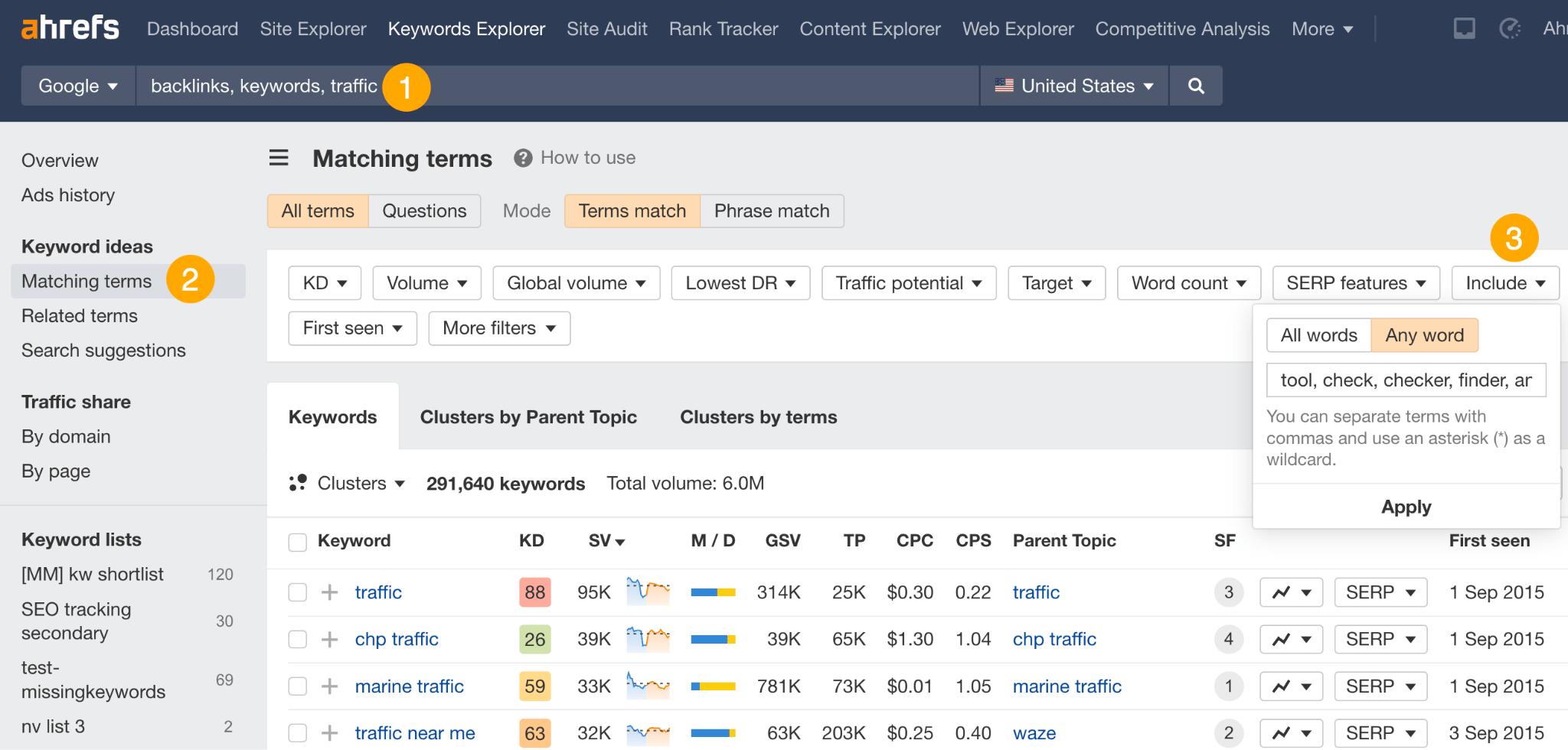
Now, to make sure the intent of the keyword calls for a tool to rank, look at the SERPs to see if tools rank at the top, or simply use AI to analyze the SERPs for you.
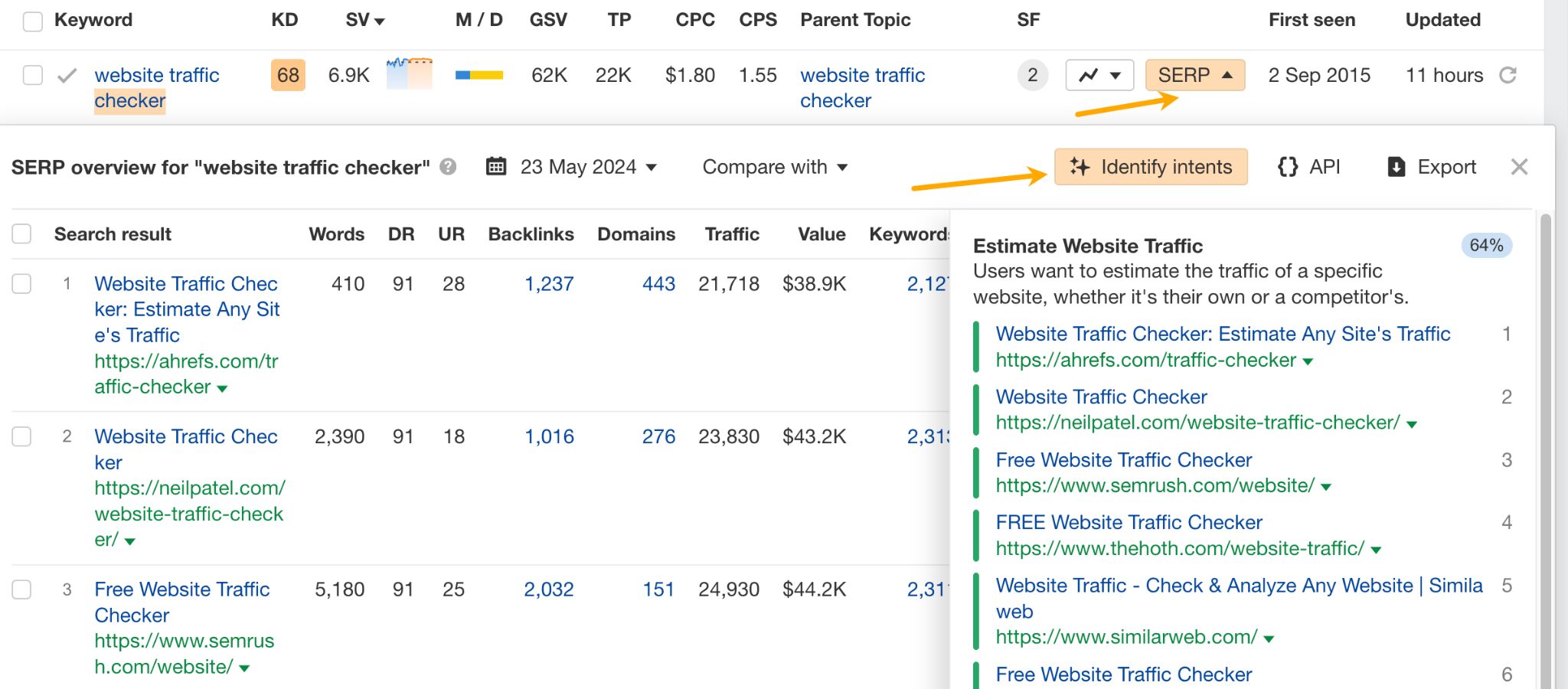
Naturally, there are other ways of finding content ideas, and you don’t necessarily need to develop apps. These could be a set of free spreadsheet templates, a set of proven AI prompts, or ready-made chatbots to use in ChatGPT.
If you’re offering services, the same principles apply. Document some free work to show people how good you are. Just like Justin Veenema, who shoots photos of strangers for free that get millions of views on Instagram.

A content hub is a centralized collection of related content organized around specific themes or topics. Its structure comprises a pillar page (high-level guide about a broad topic with links to other pages), cluster content (pages on specific subtopics), and links between the pages.
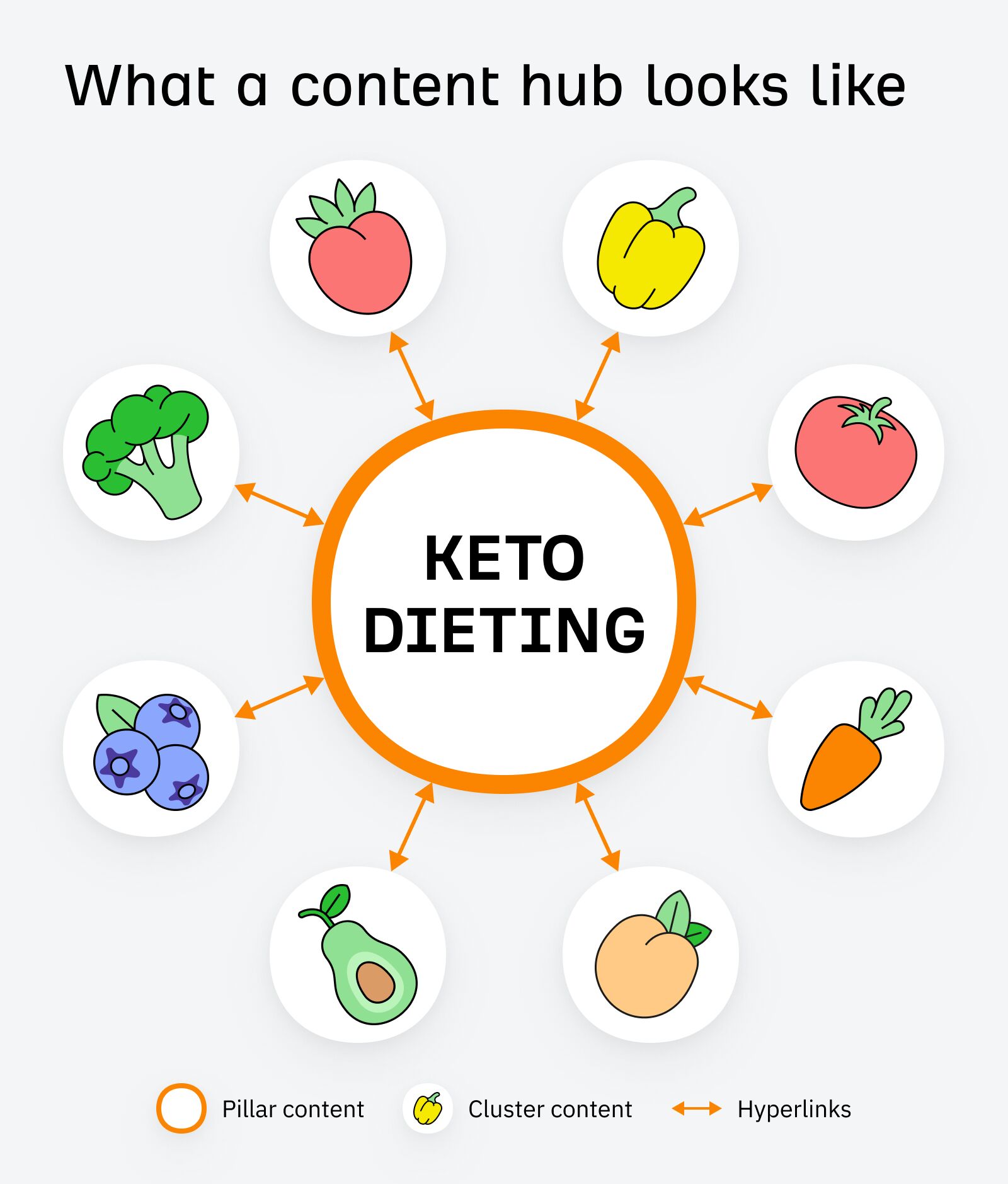
They’re an effective content marketing tactic for four reasons:
- Topical authority: Connecting your hub page and subpages with relevant internal links helps establish your site as an authority on a particular topic in Google’s eyes. Internal anchor text provides additional context to Google about the page content.
- Link authority: Strategically linking pages within a hub allows them to benefit from each other’s backlinks. This enhances the overall link authority of the hub, which can positively impact search rankings.
- Engagement: Hubs encourage visitors to explore multiple pages of content.
- Perceived value: Well-organized, comprehensive resources on a topic increase perceived value for visitors, often resulting in more backlinks as people prefer to link to the best, most useful resources.
Our content hubs emerged as a way to organize already existing content and get some additional traffic. For example, this hub is a beginner’s guide to SEO, consisting of seven articles already published as standalone articles.
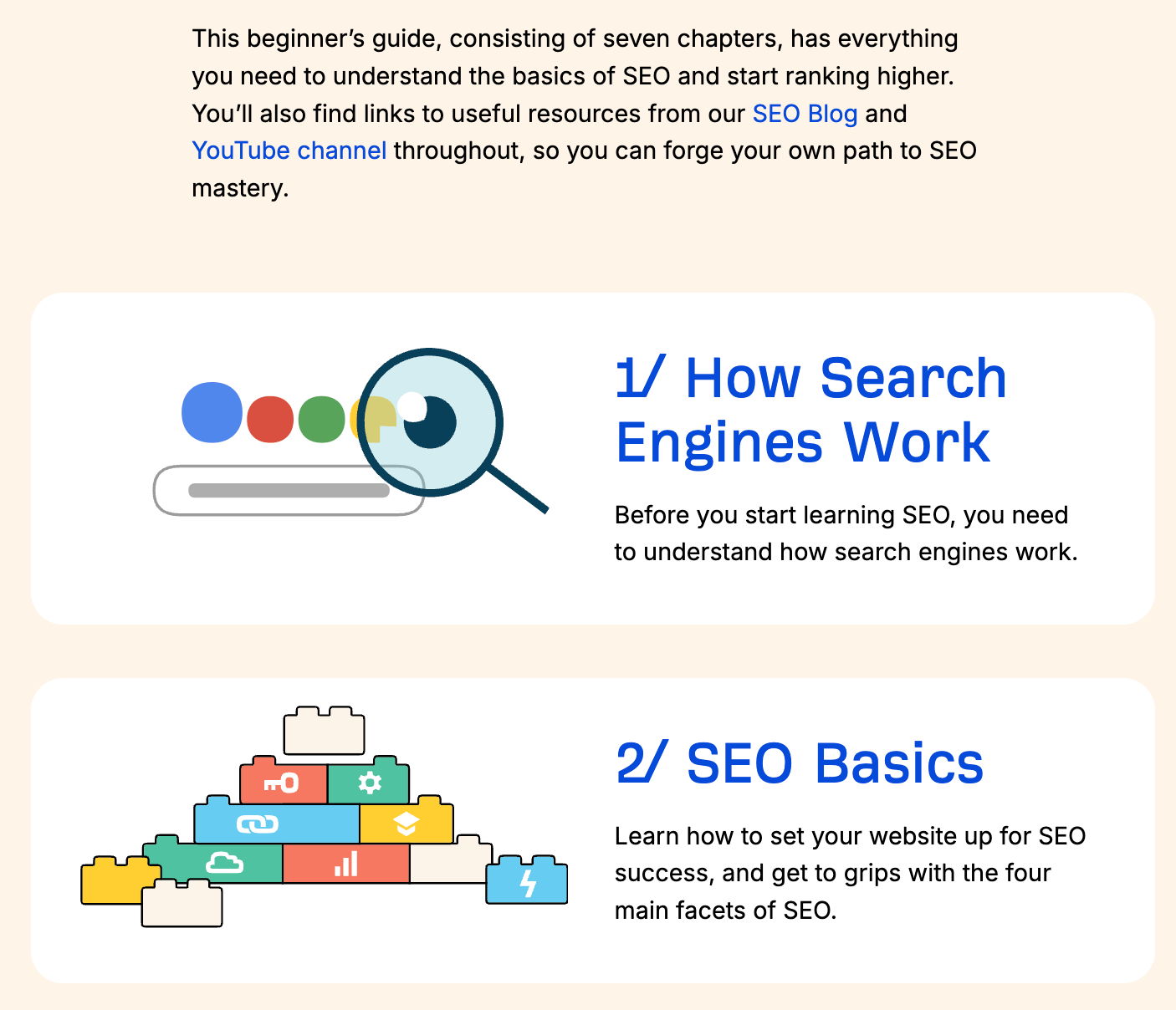
And just by reorganizing old content, we got new traffic and new backlinks.

How to get started
To find opportunities for new content hubs, the process involves three steps:
- Identify the hub topic. Choose a broad topic with informational intent, search traffic potential, and enough subtopics. Use tools like Ahrefs’ Keywords Explorer to brainstorm ideas.
- Create subpages. Develop detailed guides on subtopics related to the main topic. Ensure each subpage links back to the hub page, which links to all subpages.
- Internal linking. Use hyperlinks to connect the hub page with subpages, building a cohesive structure. This boosts topical and link authority and enhances user engagement.
See the full process in our guide Content Hubs for SEO: How to Get More Traffic and Links With Topic Clusters.
Content optimization is the process of improving the quality and relevance of content to ensure it ranks higher in search engine results, engages the target audience, and achieves specific business goals.
This tactic allows you to leverage your existing content to reach more people, often with little work involved. This can be updating old information, including a missing subtopic, making a guide more beginner-friendly, etc.
Honestly, the results can be quite amazing. For example, an article we’ve recently updated article got 20 times more traffic after just a few hours of work.
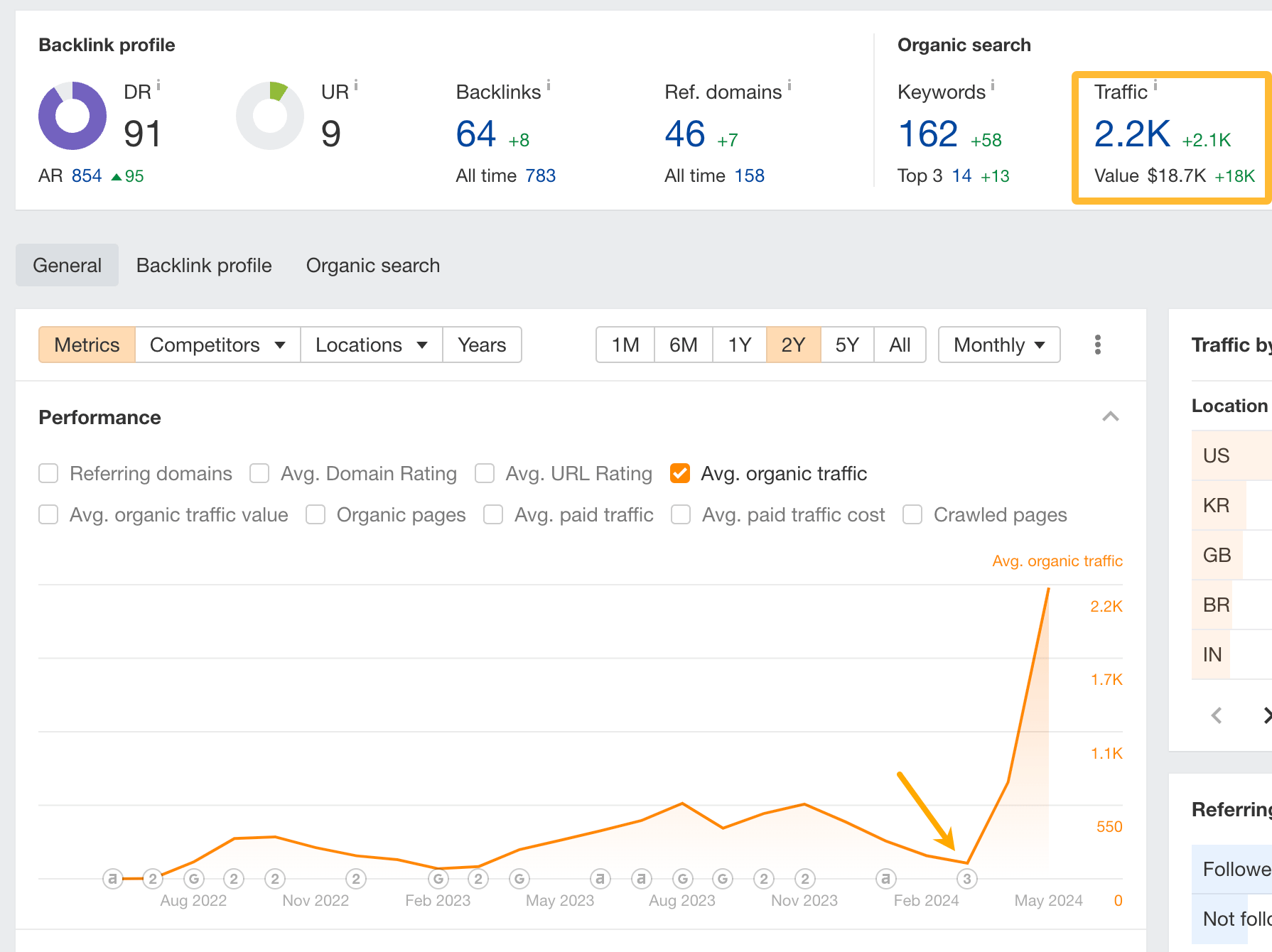
How to get started
The easiest way to spot content that needs optimization is to use Ahrefs’ Opportunities report.
- Enter your site into Ahrefs’ Site Explorer.
- Open the Opportunities report.
- Click on the Low-hanging fruit keywords to see keywords that potentially need a relatively small update to rank higher.
- Or click on the Content with declining traffic to see all pages that could use a revamp.
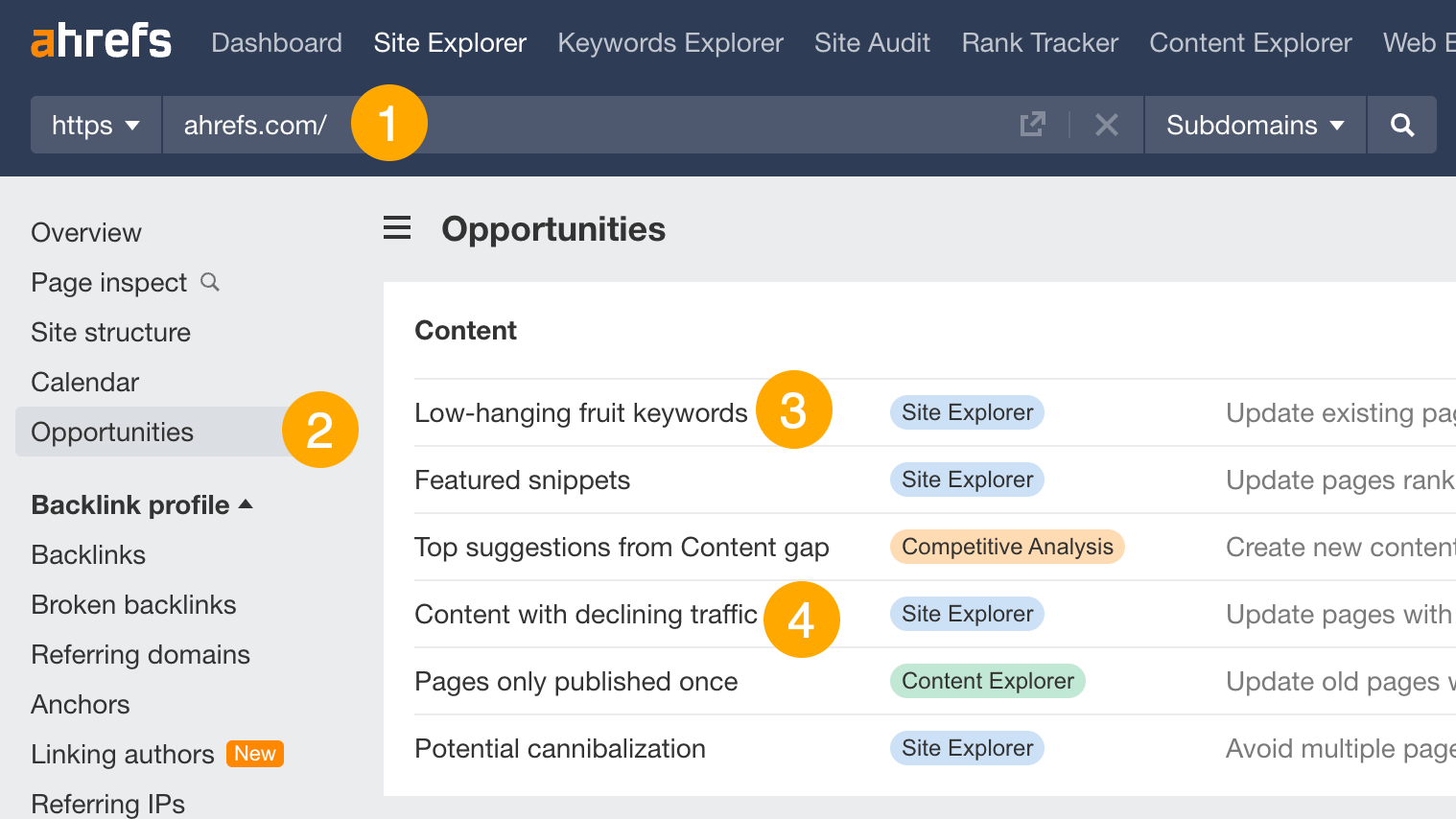
Once you find your pages, head to our guide on content optimization for some tried and tested SEO tips.
Repurposing content involves transforming existing content into different formats. For instance, a blog post can become a video shared on YouTube or a transcript of a video can be published as a blog post.
This tactic works because it helps you reach a wider audience who prefers different content formats and different platforms.
Here’s an example. We published our take on SEO checklists as a video on YouTube and then repurposed it as a blog post. The video got 240K views.

And the article gets an estimated 9.5K organic visits each month, on top of the video’s performance.
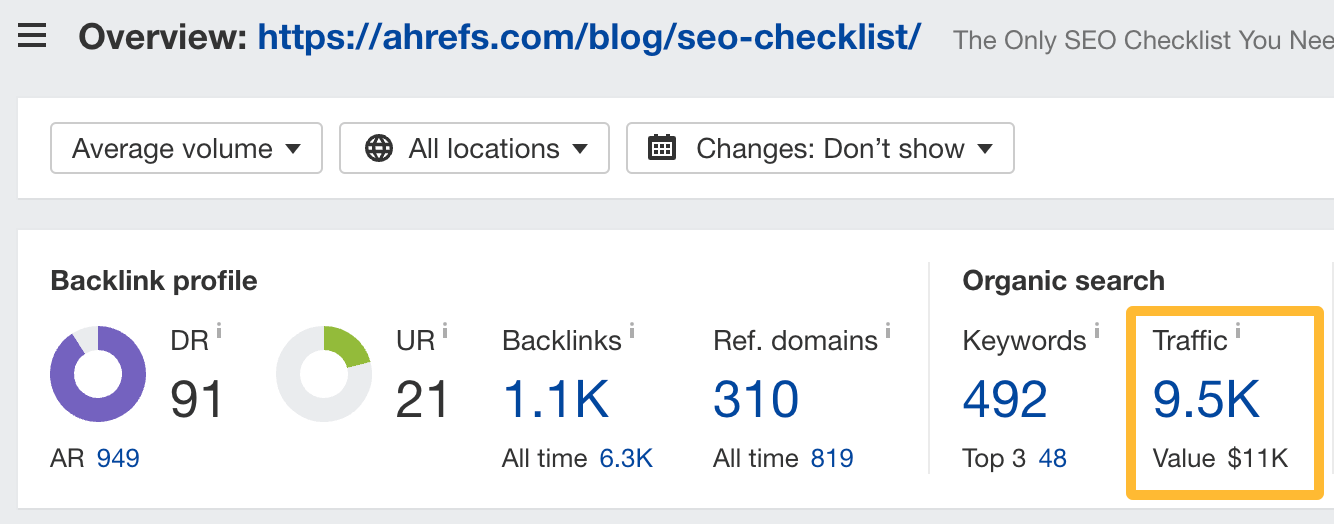
How to get started
You can repurpose any piece of content, but the best results you’ll likely get with:
- Content that has already performed well on social media. For instance, a well-received tweet thread can be expanded into a detailed article or a video script.
- Content on topics with search potential. Use a tool like Ahrefs’s Keywords Explorer to gauge traffic potential for topics you already covered.
- Evergreen topics. For example, a topic like “how to lose weight” will get attention no matter the time, platform, and format.
For more ideas and tips, head to our list of 13 ways to repurpose content.
There are three key reasons why you need translations if you’re thinking about making your business international:
- Search engines like Google and YouTube personalize search results based on language.
- Most people simply prefer content in their native language, regardless of how well they speak other languages.
- Content localization works like content repurposing — it gives you more mileage from the same content.
For example, the Spanish translation of our post about affiliate marketing brings in an estimated 7.3K organic visits each month. And that’s on top of the English version which bring 28.5k monthly visits.

How to get started
Translating every page on your site may not be the most efficient approach. Search volumes can differ between countries, so it’s important to use your resources wisely. Focus on translating your top-performing content, but only if the search volume in the target country justifies the effort.
First, use a tool like Ahrefs’ Site Explorer to get a list of your top-performing pages. In Ahrefs, you’d use the Top pages report:
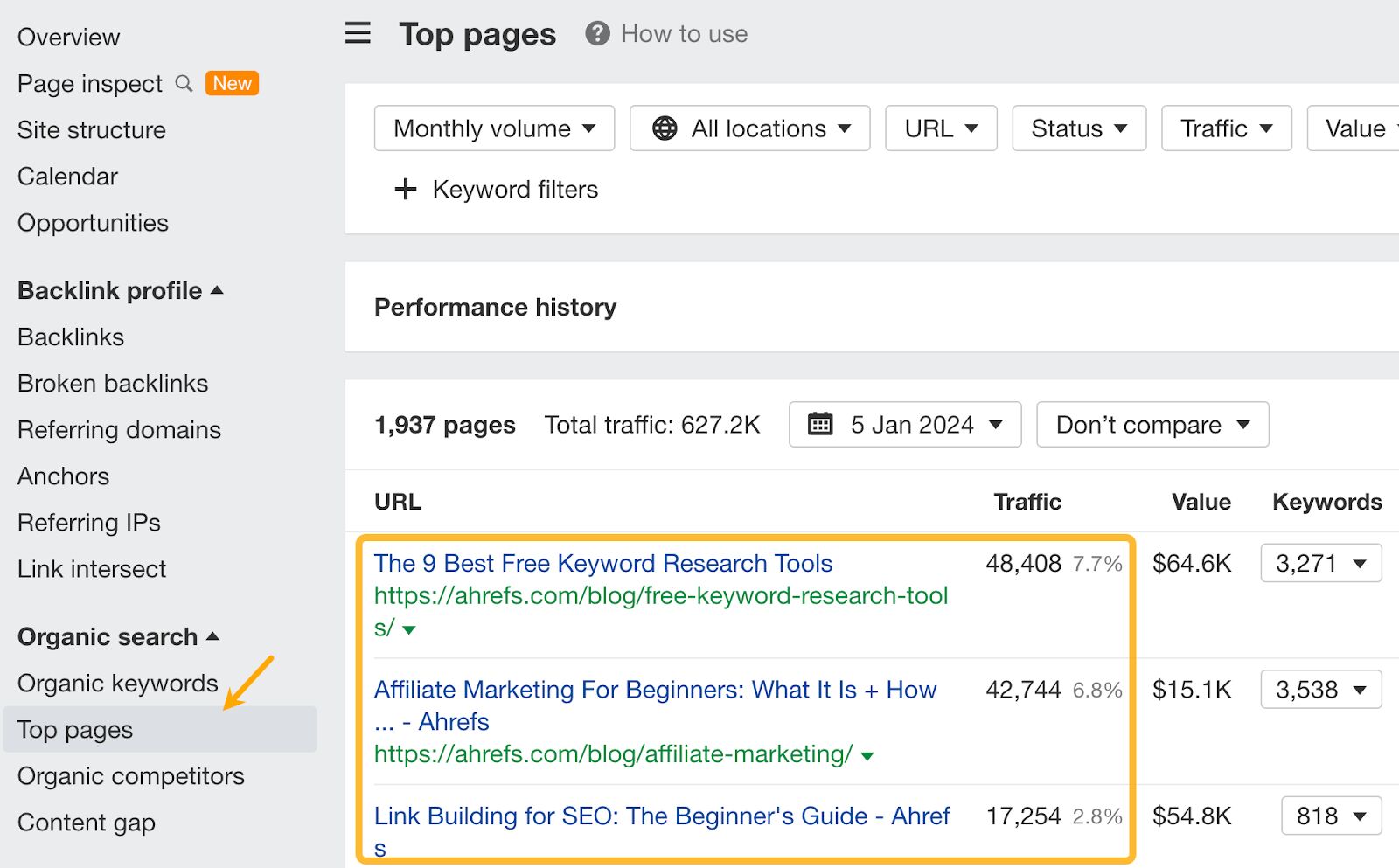
Next, you use ChatGPT to generate translations of your top pages’ target keywords. Use these translations with the free Ahrefs SEO Toolbar to simulate searches in different languages and gauge the traffic potential of a topic.
For instance, a leading French article on “free keyword research tools” receives about 714 organic visits monthly from France, suggesting potential value in content translation.

Sidenote.
If you’re using autogenerated AI translations, make sure to have them reviewed by a human, preferably someone who knows the language and culture well. AI translations are very good these days, but they can still contain mistakes or unnatural expressions that you might not catch otherwise.
The idea behind this tactic is super simple — if you keep doing the same things, you’ll keep getting the same results.
Trying out new approaches to content is important at every stage of your strategy’s maturity. In the early stages, it helps you discover what works for your business and your audience. But once your strategy is established, experimenting with new content is crucial to avoid hitting a performance plateau.
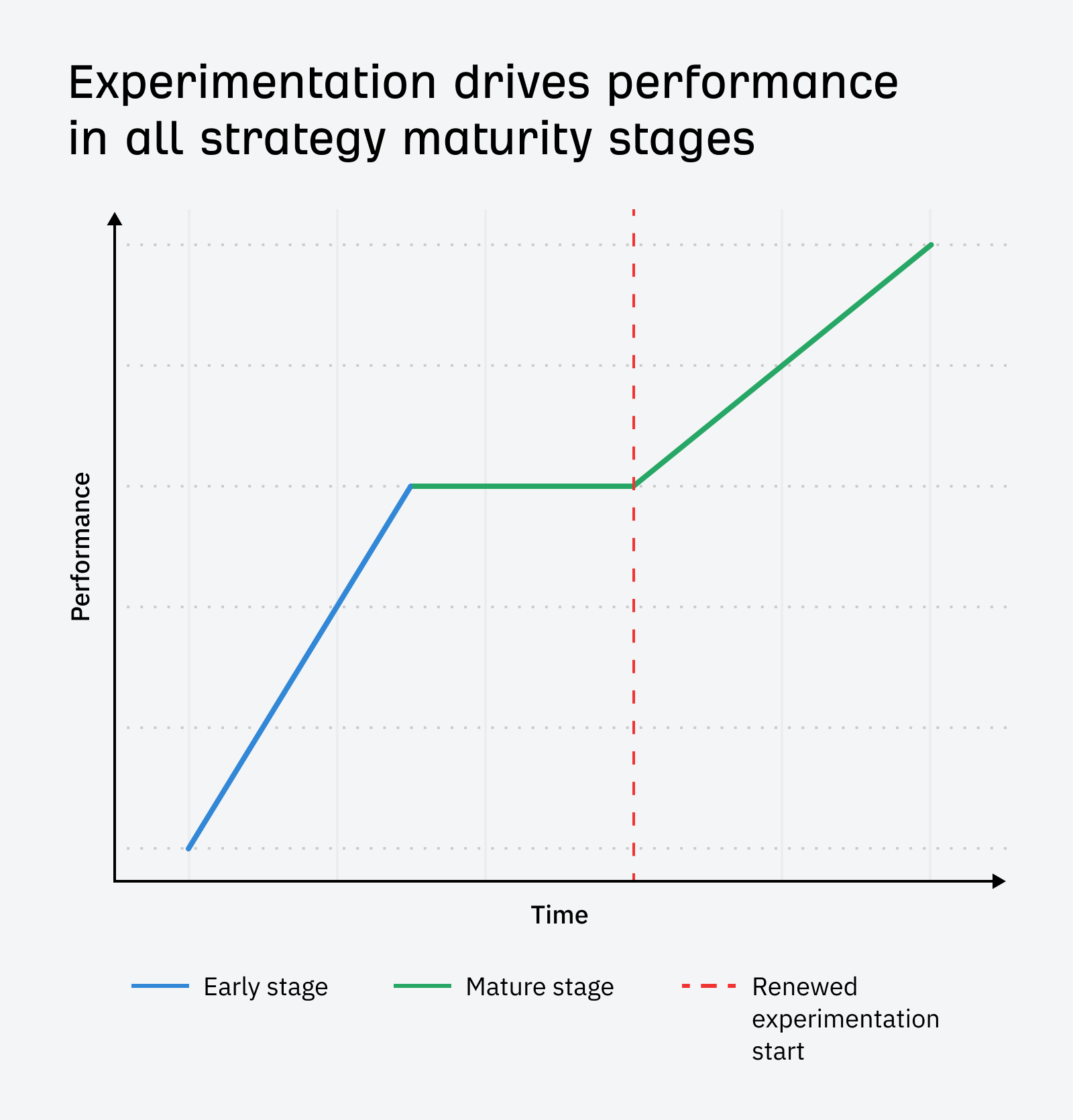
So here are some of the new things we recently tried and their results.
We released two traditional books. “SEO Book for Beginners” is our online guide to SEO repurposed in the form of a book (by the way, another great example of content repurposing we discussed earlier).

“White Haired SEO (Super Exciting Odyssey)” is an SEO book for kids, designed with parents in mind. It provides a kid-friendly answer to the question, “So what do you do at work, mum?”. To be honest, this is a bit beyond typical experimentation. It’s more like a “moonshot” but we think it’s worth making time for those, too.

Result: people love those books. When we bring them to conferences, the books fly off the shelves. For some, it’s a collector’s item; for others, it’s their kid’s favourite read. Either way, it turned out to be an effective way to delight our audience and put something tangible in their homes and offices with the “Ahrefs” name on it.
Bravo @ahrefs on creating a children’s book for SEO parents helping explain to their kids what it is we do. My favorite character is the sinister links salesman to help Jessy up Mount Fjoogle. Every story needs a heel. Great piece of content @timsoulo and ahrefs team! pic.twitter.com/cOONHwexoT
— Corey Trojanowski (@Trojanowski_) March 7, 2024
We’ve also experimented with video lately. It wasn’t easy because we were already investing a lot of effort into a quite successful formula that had been developed over the years.
So to try something new, we went from keyword research-based topics presented in “how to” style videos like this one:
To non-search topics served in a more entertaining and “light” way with elements of storytelling:
Result: this new approach led to new monthly watch time highs in several countries, including our main market, the US.

How to get started
Here are some tips that can help you spark some new ideas and get them into production.
- Organize regular brainstorming sessions with a few people. These sessions should encourage open, uninhibited discussions where everyone can contribute their thoughts and suggestions.
- Try a few courses. Enroll in courses that focus on content creation, digital marketing, or any specific area relevant to your field. These courses can provide fresh perspectives, new skills, and innovative techniques that you can incorporate into your content strategy.
- Book a consultation with a pro. Seek advice from professionals or mentors who have successfully navigated the path you’re aiming to take.
- Use new tools to source ideas. Try tools like Ahrefs Keywords Explorer, Sparktoro, Buzzsumo, or Glimpse.
- Embrace a mindset of experimentation. Trying out new content formats and topics involves taking risks, but big rewards too.
Final thoughts
In marketing, it’s not really about how many tactics you use or how smart, creative, or unique they are. What matters is how you execute them. You can have a thriving business by employing just a few tactics but doing them well enough to bring you visitors on a constant basis.
So feel free to try all of the ideas we shared in this article, but we encourage you to double down on the things that work.
Got questions or comments? Find me on X or LinkedIn.
Content Copyrights Belong to The Author. All Rights Reserved.
We're A Dallas Digital Marketing Agency That is Experts At Social Media Marketing, Website Design and Emarketing and Promotion.



